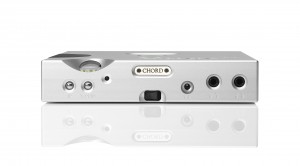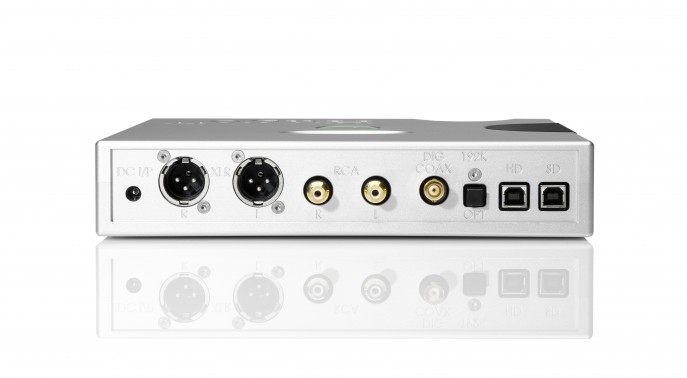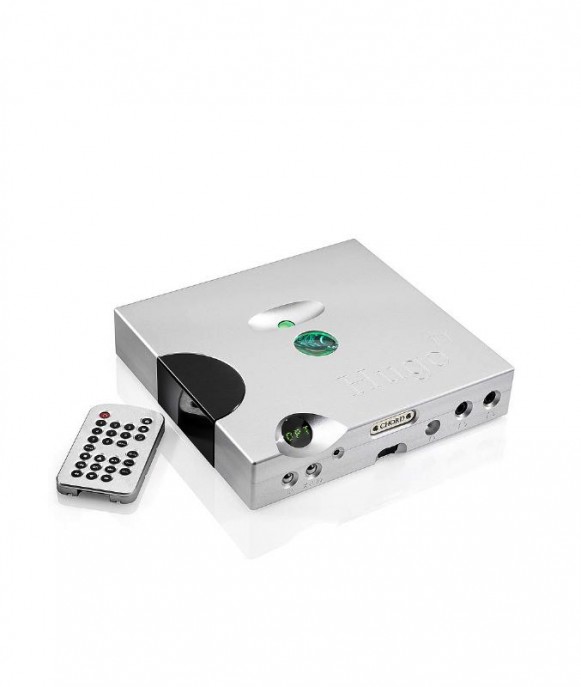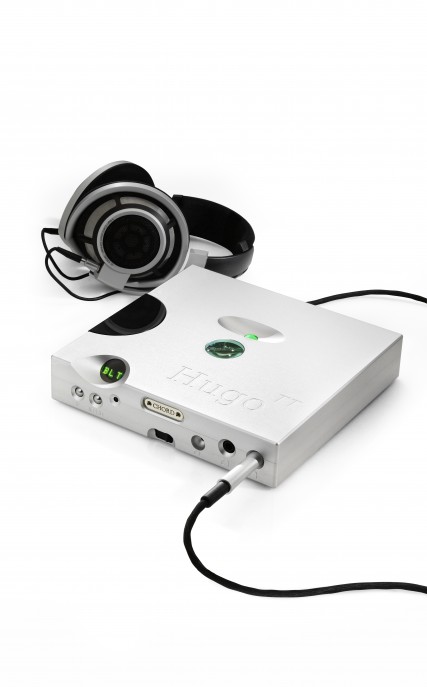So anyone with any real history in the audio world is aware of the term: “diminishing returns”. I certainly have experienced it when moving up the audio food chain as you get closer and closer to the top. When it comes to digital sources, such as digital-to-analog converters (DACs), I’ve found this general law to be quite strong. As I moved up the ladder, I especially found that the improvements (while still audibly detectable) became harder and harder to discern as the equipment improved beyond the $1500 or so price point. To say that my current DAC (Metrum Acoustics Hex, $3500USD) was night and day better than the one it replaced (Bryston Audio BDA-2, $2395USD) would be a large over-statement in my most honest opinion. This is where the Chord Hugo TT comes in.
When Frank Iacone asked if I had some time available to review the new table top DAC/Headphone Amplifier by Chord Electronics, I leapt at the opportunity as I was so very thoroughly impressed with its little brother, the portable Chord Hugo. It was one of the very best portable DAC/Amps I’ve heard, and its ability to power even full sized power hungry headphones to levels many desktop solutions couldn’t had me excited to hear its bigger brother. Unlike my past experiences, when I started to listen to the Hugo TT, that law of dimension returns seemed to be not applicable in this case. Instead what I heard was a revelation on just how much better things could get with my favourite recordings!
So after only a few short days from happily agreeing to do this review, the new Chord Hugo TT arrived to me in Canada from the UK and upon opening the box, I found that the TT did very much maintain the unique design motif of the original portable Hugo. But everything was just bigger and that much more impressive. Now this is certainly not a portable device; however, its small footprint would work extremely well for those with limited desk or shelf space. While small, the Hugo TT has a heft about it, coming in at 3kg (6.6 lbs), that certainly let’s one know that there is quite a bit going on under the hood (more on that later). The case work is really top shelf worthy. It is beautifully presented (my review unit came in black; there is also a silver option available) and looked very impressive in my setup. The usage of LED lights to denote the bitrate of the music, or the volume that was output is very unique and worked remarkably well to inform me where things were at all times. From an input/output perspective, the Hugo TT like its portable predecessor, doesn’t miss a beat.
Inputs
- 1x Optical TOSLink 24-bit/192KHz-capable
- 1x BNC coaxial input 32-bit/384kHz -capable
- 1x HD and SD USB B-type input up to 32-bit/384kHz
Outputs
- 1×3.5mm headphone jack
- 2×6.35mm (1/4-inch) headphone jack
- 1x (pair) stereo RCA phono output
- Fully balanced via XLR connectors
Being fully designed in-house, the Hugo TT utilizes the Spartan-6 FPGA (also used on the portable Hugo) and was fashioned to run continuously from the supplied charger. However the Hugo TT has also improved the battery and added Supercap energy storage: a technology seen in F1 where supercacitors back-up the cars batteries by sharing the load and charge demands and thereby protecting them. They serve a similar purpose in the Hugo TT, extending the battery life as well as improving dynamics and demanding transients in recorded music. The designers at Chord Electronics in the UK certainly seemed to have thought of everything in order to make the TT a no holds barred big brother to their already very popular and well received portable Hugo that was released just a few years ago.

For my review, I used the Hugo TT as both a standalone DAC that fed my HeadAmp GS-X Mk2 or my Cavalli Audio Liquid Lightning 2 in balanced mode, and as an all-in-one setup where I was able to use the built in amplifying capabilities. My source material was either CDs played through my Cambridge Audio Azur 650C CD player via SPDIF input, or 192kps AIFF files and DSD files via the HD USB input. I used a plethora of different headphones to put the Hugo TT through its paces; from traditional dynamic headphones (Sennheiser HD800, Beyerdynamic T1 version 2 and Grado PS1000e), to orthodynamic headphones (Hifiman HE1000, Audeze LCD-X and Oppo PM-3), to the electro-static Stax SR-007 Mk1 and SR-009 headphones. This would enable me to fully understand the nature of the Chord Hugo TT with a wide variety of flagship headphones and how it would pair with their unique signatures.
First up, I replaced my trusty Metrum Acoustics Hex DAC with the Hugo TT as the main DAC in my rack. The setup was quite straight forward and when paired with the instructions provided from Chord Electronics, it was very straight forward and quick to get up and running. I have to say that I am very impressed with the different lighting schemes utilizing various LEDs that the folks at Chord have come up with to denote whether the unit is used as a standalone DAC, or DAC + Headphone amplifier, or the volume that the amplifier is set to and even the bitrate of the incoming music from either my iMac or CD player. Just a quick glance at the TT and I knew exactly where I was and what was going on.
So after a quick setup and familiarization with the Hugo TT, I chose to use it first as a standalone DAC feeding my Cavalli Audio Liquid Lightning 2 electrostatic amplifier which powers my electrostatic Stax SR-009 headphones (my favourite pair of headphones of all time). The music I selected was my DSD version of Jazz at the Pawnshop. I’ve often used this recording via CD to put a particular piece of gear through its paces, but this is the first time I was able to use it with my main headphone setups as none of my previous other DACs have been able to play DSD files. Just as the crowd background chatter kicked in on the recording I knew I was in for something truly special. I was able to hear the talk of the patrons at the Pawnshop with a clarity that I didn’t think was possible.

Now I’ve been impressed before with the CD or FLAC versions of this recording, but they have never come so alive as if I was center stage as with this DSD recording played through the Hugo TT. As my sense of amazement continued, “Limehouse Blues” started up and my jaw must have dropped. I find the Liquid Lightning 2 / SR-009 combination an incredibly revealing setup that is truly a microscope to the smallest nuances contained in a recording, but this setup with the Hugo TT just brought things to a whole new level! I didn’t realize what cards I was leaving on the table until I experienced it through the TT. I then wanted to determine how much of the difference was due to the DSD file versus my standard CD or FLAC files, so after the album was done I quickly switched to the lower bitrate recordings options. Yes, the DSD recording was indeed fantastic, the FLAC recording was still outstanding and if I had not heard the DSD version, I would have maintained that was the best that Jazz at the Pawnshop had ever sounded. So kudos to the Hugo TT for not only playing the DSD recording with such transparency and clarity, but it certainly was not limited to DSD recordings. Both FLAC and CDs sounded incredibly clear and concise and most likely the best I’ve heard the non-DSD versions of that album sound.
The details and clarity of the xylophone immediately grab your attention, and the harmonics, presence and decay of each note sent shivers down my spine. This level of detail and “trueness” to what I’m used to hearing in real life just never got this close as with this setup. Each instrument was placed in the sound-scape in a way that a truly holographic effect was portrayed and the image that resulted was as transparent as I’ve ever come across. Bass was full and present, but never lingered more than required, the details and layering to the mid-frequencies was perfect to my ears. Speaking of mids, the Hugo TT was able to hit all the right notes as well; never were they subdued or set back in the soundstage. This is where the “meat” of the audio recordings is contained, and the Hugo TT was all Grade A! With a treble-tilted source or amplifier, the Stax SR-009s can come off a bit bright and can fatigue over time. This was one of the biggest selling factors for me with the NOS (Non-Oversampling) Metrum Acoustics Hex DAC as it was a perfect mate for my favourite headphones. Previous DACs that I’ve owned did give them a bit too much focus and glare in the treble region and when the Hex arrived, I rejoiced at no longer having to live with that slight glare. Thankfully the Hugo TT continues in that tradition, but with an improved quickness and nimbleness that I never thought possible. Stax headphones are renowned for their speed and transparency in the treble region and as before the Hugo TT just brought things to a whole new level that I didn’t think possible.
Next up were the Sennheiser HD800s and Beyerdynamics T1 V2 headphones with my HeadAmp GS-X Mk2 dynamic headphone amplifier. For this session I selected some of my favourite classical music recordings by Gustav Mahler. I have several of his symphonies in FLAC (192kps) and thought it would be an ideal test of the Hugo TT and its ability to render a sound stage and handle some very complex pieces. Both the HD800s and T1s are very well voiced for classical music and have the ability to throw an impressive soundstage when the upstream is up to the task. I’ll use the word “and” quite often from here. The sound-staging was the best I’ve heard, and the bass was as textured/detailed as ever and the mids were as seductive as I’ve ever heard and the treble was as true-to-life as ever. I think that’s a lot of “ands” and the Hugo TT delivered on it all. I like to focus on the cornet/trumpets in classical recordings as I’ve been a trumpet player (certainly not my day job however) for over 35 years. The Hugo TT when paired with the GS-X Mk2 headphone amplifier rendered that instrument with a sense of realism and depth that was as true as I’ve ever heard it. The timbre and tonality was spot on, the vibrato and decay was eerily real and every last detail was extracted from the recording; to the point where I could tell that the spit valves needed to be emptied at times (something I wasn’t able to discern previous to the Hugo TT’s arrival).
Finally I wanted to put the amplifier section of the Chord Hugo TT to the test. For this portion I used all of the dynamic headphones I had on hand (including my Westone W60 in-ear monitors). Unfortunately the biggest limitation with my electro-static headphones is that they require a dedicated electro-static amplifier to power them separately. The music I selected here was more in-line with my musical tastes; Led Zeppelin, Pink Floyd and Rush (as you can see from my Head-Fi avatar, the”Fly by Night” album cover).

The Hugo TT was particularly impressive with the Grado PS1000e and Audeze LCD-X headphones. Let me tell you that the amplifier portion is NOT a throw in. It is remarkably powerful and dynamic and bests many standalone amplifiers costing $1500+ and much more that I’ve heard over the years. While I would classify the DAC portion as strictly neutral/natural, the amplifier offers a slight warmth to the headphones that makes it hard to tear myself away and go to bed. In fact, I’ve had several late nights with the Hugo TT since its arrival due to its addictive nature. The amplifier was forceful and very dynamic. As well, the quickness that I came to love with the DAC section continued to shine through when I used the amplifier section to power my headphones. The Grado PS1000e and Audeze LCD-X sounded as enjoyable when played through the Hugo TT exclusively as they did when I fed the Hugo TT to my HeadAmp GS-X Mk2 dedicated headphone amplifier. This amplifier is my favourite solid state headphone amp that I’ve come across and doesn’t come cheap at approximately $3000 USD; and the fact that I found it superfluous with the Hugo TT with these two top notch headphones certainly says a lot.With the Sennhieser HD800, Beyerdynamics T1v2 and Hifiman HE1000, the Hugo TT again was a real winner. The amplifier never ran out of steam with these more power hungry headphones and offered plenty of headroom and control of the drivers. The HD800s in particular can be like my 7 year old son at the dinner table: very picky of what’s coming in. Get that wrong and both will leave you disappointed. And the Hugo TT / HD800s were simply an outstanding combination! If you love the HD800’s sound signature, the Hugo TT will extract every last detail out of the recording in a way that is still musical and very enjoyable. However, I did slightly prefer the Hugo TT paired with my HeadAmp GS-X Mk2 with these harder to drive headphones. The GS-X Mk2 outputs a whopping 5 W of power and while the Hugo TT was excellent with these headphones, when paired with the GS-X Mk2, I felt that I was getting the absolute maximum out of these headphones that was possible, period. That’s certainly not to say that the Hugo TT left me wanting, but if you want the absolute final word in transparency and driver control, pairing the Hugo TT with the HeadAmp GS-X Mk2 was certainly that for me.
Now the Chord Hugo TT is not a “starter” unit. It comes in at a pricey $4750US, but for at this price point you are getting a truly outstanding desktop DAC/Headphone Amplifier that is truly world class. With every headphone or recording that I threw at it, the Hugo TT just continued to impress me! My cheeks are a bit sore from the constant smile that’s been on my face for the past several weeks. If you’re looking for a wonderfully transparent, clean and versatile DAC or if you’re looking for an all-in one desktop amp/DAC solution and “money is no object”, I can wholeheartedly recommend the Chord Hugo TT! It hits on all cylinders for me: from its diverse number of inputs (SPDIF, OPTICAL, USB x2, and even Bluetooth), to its world class DAC to it incredibly powerful and dynamic amplifier. The build quality of the construction and the addition of the LED lights to always let you know what’s going on with your audio system is among the very best that I’ve seen. When it comes to my vote for “component of the year”, the Hugo TT will most certainly be in the mix for me to consider. Highly recommended!















Reply
Reply
Reply
Reply
Reply
Reply
Reply
Reply
Reply
Reply
Reply
Reply
Reply
Reply
Reply
Want to join discussion?
Feel free to contribute!